Food is more than nourishment; it’s culture, history, and tradition on a plate. Among Indonesia’s many culinary treasures, Nasi Kuning (literally “yellow rice”) holds a special place. This golden-hued dish, infused with turmeric, coconut milk, and aromatic spices, is more than just a staple; it’s a symbol of prosperity, celebration, and communal joy.
If you’ve ever admired a beautifully plated Nasi Kuning pyramid at a wedding, birthday, or cultural ceremony, you’ll know it’s not just food—it’s art. In this guide, we’ll dive deep into the history, cultural symbolism, preparation techniques, and insider tips to help you master the art of kuning at home.
🌟 1. The Cultural Significance of Nasi Kuning
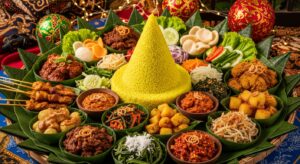
Before diving into cooking, it’s important to understand the heritage behind kuning:
-
Symbolism of Prosperity: The golden color represents wealth, happiness, and good fortune. Traditionally, it’s served during weddings, birthdays, or opening ceremonies to wish blessings upon families.
-
Offerings and Rituals: In Javanese and Balinese traditions, kuning is often part of offerings to ancestors or deities, showing gratitude.
-
Tumpeng Style: Nasi Kuning is often molded into a cone (called tumpeng) surrounded by side dishes like fried chicken, sambal, tempeh, eggs, and vegetables, symbolizing harmony in life.
Understanding this cultural depth makes cooking kuning more than a recipe; it becomes storytelling.
🍚 2. Essential Ingredients for Authentic Kuning

The magic of kuning lies in its flavor balance and fragrance. To master it, you’ll need:
-
Rice: Long-grain or jasmine rice is preferred for a fluffy yet firm texture.
-
Turmeric (Kunyit): Fresh root or powder gives that iconic golden glow and earthy aroma.
-
Coconut Milk: Creamy richness that softens the spice and elevates flavor.
-
Lemongrass & Kaffir Lime Leaves: Bring citrusy freshness.
-
Galangal & Bay Leaves: For warmth and depth.
-
Salt & Pandan Leaves: To enhance fragrance and natural sweetness.
💡 Tip: Always rinse your rice thoroughly before cooking to remove excess starch and achieve fluffiness.
🔥 3. The Traditional Cooking Method
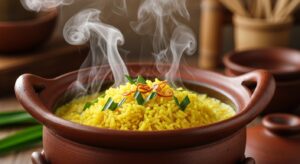
There are two primary ways to cook kuning:
a) Steamed Method (Traditional)
-
Rice is half-cooked first.
-
Then steamed with coconut milk, turmeric, and spices.
-
Produces light, non-sticky grains—perfect for ceremonial plating.
b) Rice Cooker Method (Modern)
-
All ingredients go into the rice cooker.
-
Easier for home cooks, though the texture may be slightly softer.
💡 Pro Tip: For the best of both worlds, parboil rice briefly, then transfer to a rice cooker with coconut milk and spices.
🥥 4. Achieving the Perfect Golden Hue
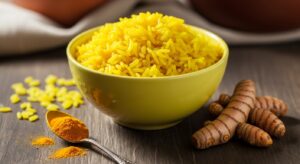
The beauty of kuning lies in its sunshine-yellow glow.
-
Use fresh turmeric root for the most vibrant color (blend it into a paste).
-
Turmeric powder works too, but may give a duller tone.
-
Avoid overusing turmeric—it can make the rice bitter.
👉 Trick: Add a small pinch of ground coriander or cumin to deepen color without affecting flavor.
🍗 5. Side Dishes to Complement Kuning
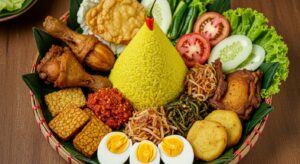
A plate of kuning isn’t complete without its companion dishes. These sides balance texture, flavor, and symbolism:
-
Ayam Goreng (Fried Chicken): Crispy, savory, a family favorite.
-
Sambal: Spicy chili paste that adds a fiery kick.
-
Perkedel (Potato Fritters): Crispy outside, soft inside.
-
Tempeh or Tofu: Nutty and protein-rich.
-
Boiled Eggs: Usually halved, representing rebirth or new beginnings.
-
Vegetables: Steamed green beans, cucumber, or fresh salad for balance.
💡 Tip: Arrange side dishes around the rice cone in a circle, symbolizing unity.
🎨 6. The Art of Presentation
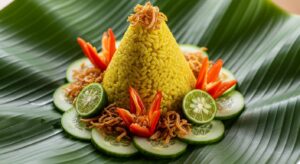
Plating kuning is as important as cooking it. To impress, try these techniques:
-
Tumpeng Cone: Use a mold to shape rice into a tall cone.
-
Banana Leaves: Serve on banana leaves for authenticity and extra aroma.
-
Layered Plating: Alternate rice with garnishes like fried shallots for visual appeal.
-
Garnishes: Fresh cucumber, chili flowers, or lime wedges add freshness.
👉 Remember: The plate should feel like a celebration, not just a meal.
🌿 7. Health Benefits of Kuning

Beyond its cultural charm, kuning is also nutritious:
-
Turmeric: Anti-inflammatory, boosts immunity.
-
Coconut Milk: Provides healthy fats for energy.
-
Rice: A source of carbohydrates and fiber (if using brown or red rice).
-
Spices: Aid digestion and improve gut health.
💡 Healthier twist: Replace white rice with brown rice or quinoa for a modern spin.
🕰️ 8. Common Mistakes and How to Avoid Them
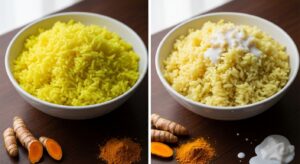
-
Rice Too Mushy: Add too much coconut milk—stick to the right ratio (1 cup rice: 1.5 cups liquid).
-
Bitter Flavor: Too much turmeric. Start small, then adjust.
-
Uneven Cooking: Stir rice halfway through cooking to distribute flavors.
-
Flat Taste: Don’t skip aromatics like lemongrass, galangal, and bay leaves—they define kuning.
🌍 9. Modern Twists on Kuning
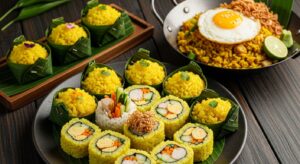
While traditional recipes are timeless, you can experiment with:
-
Nasi Kuning Sushi Rolls: Use yellow rice instead of white for creative fusion.
-
Mini Kuning Cups: Serve in small banana leaf cones for parties.
-
Kuning Fried Rice: Use leftover kuning to make flavorful fried rice the next day.
🏆 10. Step-by-Step Guide to Mastering Kuning at Home
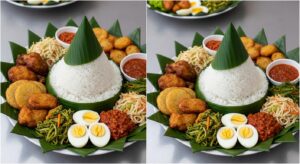
-
Rinse rice until the water runs clear.
-
Blend turmeric with lemongrass, galangal, and garlic (if using fresh).
-
Heat coconut milk with spices, bay leaves, and salt.
-
Add rice and cook until the liquid is absorbed.
-
Steam or transfer to a rice cooker to finish cooking.
-
Shape rice into a tumpeng cone.
-
Arrange sides (fried chicken, sambal, tempeh, etc.) around rice.
-
Garnish with fried shallots and cucumber slices.
-
Serve warm with smiles and celebration.
-
Enjoy your masterpiece!
💡 Final Thoughts
Mastering the art of kuning isn’t just about following a recipe; it’s about embracing a centuries-old tradition where food meets symbolism, beauty, and community. From the golden turmeric hue to the celebratory plating, each step is an opportunity to connect with Indonesian heritage.
Whether you’re preparing it for a cultural event, a family gathering, or simply to challenge yourself in the kitchen, kuning will never disappoint. With these tips and tricks, you’re now equipped to create a dish that’s as stunning as it is meaningful.
So, roll up your sleeves, gather your spices, and let the golden glow of kuning brighten your table.